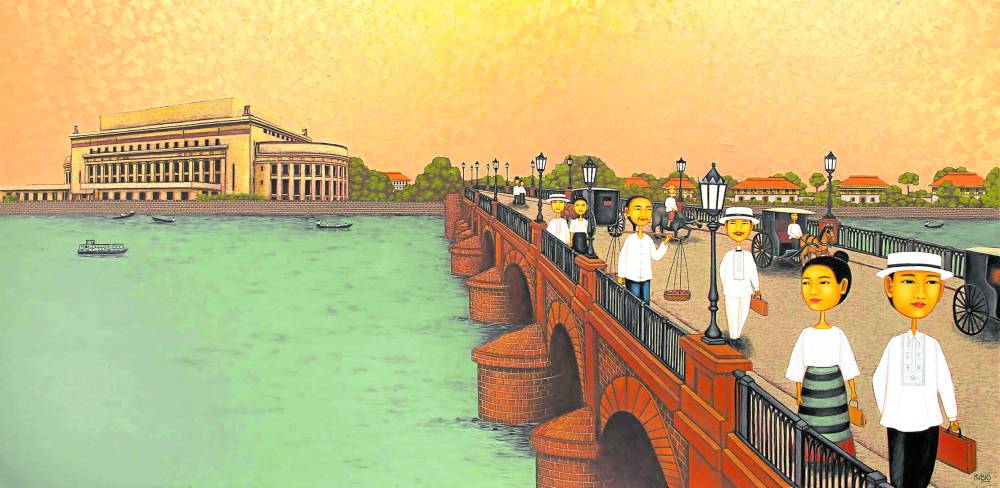
Up on the third floor, looking out the veranda, one could see the tops of trees gaze up at the vast blue sky, the occasional flitting bird a messenger of secrets between them. It’s a peculiar sight in commercial areas that makes one grateful for urban design that doesn’t eradicate nature’s beauty.
Behind the glass walls, there’s a different kind of beauty to behold—man-made—cradled in imagination, inspired by history and infused with modernity.
As if a testament to art’s capacity to endure, even through a years-long global pandemic, Galleria Nicolas recently opened a new branch in Greenbelt 5 with an exhibit from contemporary artist Dominic Rubio, titled “Ilustrados,” from Jan. 7 to Jan. 16. It is the second installment to Rubio’s monthlong birthday celebration trilogy (the first in Power Plant Mall in Rockwell, Makati, and the last to be held at Bonifacio Global City, Taguig).
Known during the Spanish colonial period as the “enlightened ones,” Ilustrados were middle-class Filipinos who had been educated in Spain and became prime movers of Philippine history due to their exposure to a broad range of ideals.
‘Miniaturismo’
Done in his signature combination of “long neck,” featuring distorted proportions (big head, elongated neck, small hands), and “miniaturismo,” paying particular attention to accoutrements, “Ilustrados” is an homage to the elegant educated class of 19th-century Philippines.
Originally a sculptor, he has slowly been returning to his first love, turning the characters from his paintings into wooden 3D art.
“I’m from Paete, so I was really a sculptor. That was my bread and butter,” Rubio said. But because it was hard to lug the pieces around, he decided to try painting instead—”kasi nakarolyo lang.”
But now that he has become an established painter, he wanted to go back to sculpting. Five years ago, he launched his first pieces in Manila Art, popping his subjects out of the canvas and into three-dimensionality.
“Many people liked it. They say my paintings came out of the canvas, became 3D,” said Rubio. “It’s really nice making them because there are so many things you can do since it’s 3D, as opposed to the flat painting.”
Right now, his sculptures mainly depict characters similar to the subjects in his paintings. But perhaps later on, he said, he could do a retablo style where he can add a backdrop with all the little details—something he has also been known for in his artworks. But that’s still a long way off, he said, adding that he first has to fulfill the demand for his current style before he could move on.
Right now, Rubio is grateful his paintings remain as memorable and marketable as ever. “It’s hard for artists to find their own style, so distinct that even without seeing their signature, patrons already know they made it.” He said he just chanced upon my style, which collectors happened to like and now continue to look out for.
But he said he had to grow and learn to take criticism throughout the years. “Before, I would already get shaken up when someone comments about my artwork. But that shouldn’t be the case.”
He compared his relationship with the gallery to that of a boxer and his coach: “It’s just like (Manny) Pacquiao and Freddie Roach. Pacquiao is skilled, but he couldn’t see his play inside the ring. The one who sees it is his coach. The gallery is my coach.”
Jump-off point
And his talks with his best friend Jack Teotico, owner of the chain of galleries that include Galerie Joaquin and Galleria Nicolas, often lead to great things. His collaboration with Time Master watches was a result of such “kwentuhan lang.”
The artist revealed that it had been his dream to have a “Rubio na relo” ever since he visited Barcelona and saw the “melting” Dali watch. The brand released limited pieces featuring a tiny version of his “Ilustrado couple” painting in their Apollo line, but Rubio said another design will be coming out looking more like a miniature painting with its square frame and the painting covering the entire watch face.
Aside from timepieces, Rubio has also had collaborations with Vespa where he painted directly on the motor and then subsequently incorporated the scooter into his paintings. Furthermore, the consummate artist has dipped his masterful hands into fashion and jewelry making as well.
Aside from established artists (Jay Ragma’s “Reflective Echoes” was on exhibit until Jan. 26), Galleria Nicolas also aims to be an incubator for rising new talents as well, managing director Carla de Jesus-Teotico said.
“This gallery in particular is like a jump-off point from our flagship Galerie Joaquin,” she added. “Galleria Nicolas caters more to up-and-coming artists and artists who do experiments with different works. Or if they have a collection that they want to try out if they’re coming up with something new, we have Galleria Nicolas for them to explore and be creative with.”